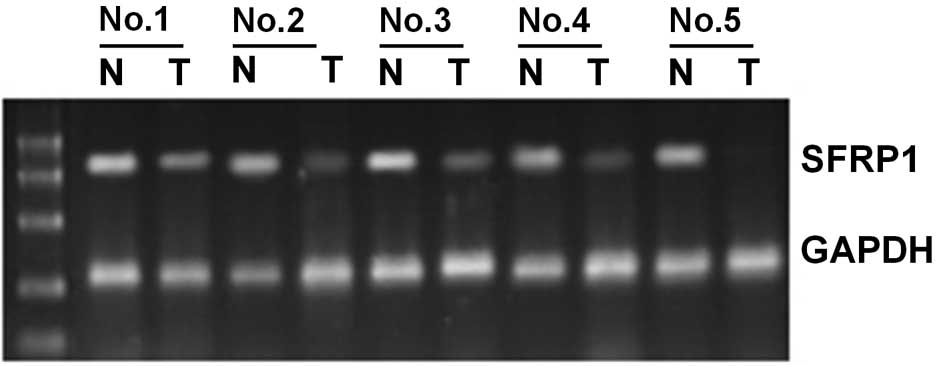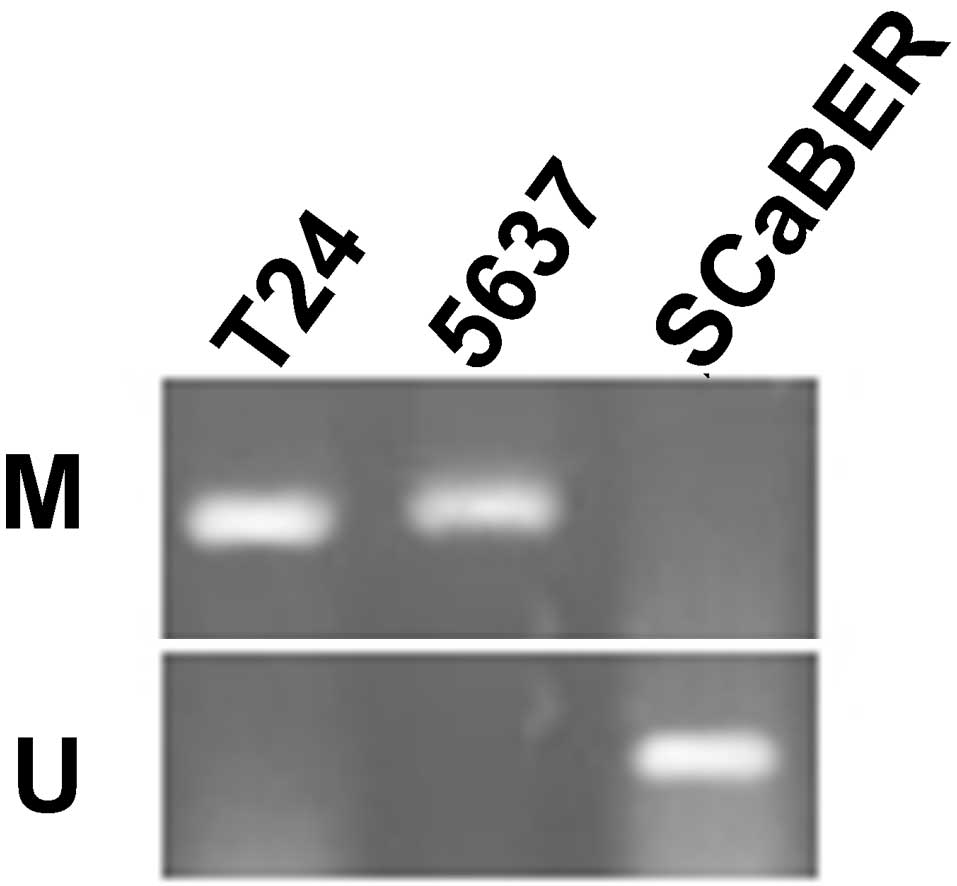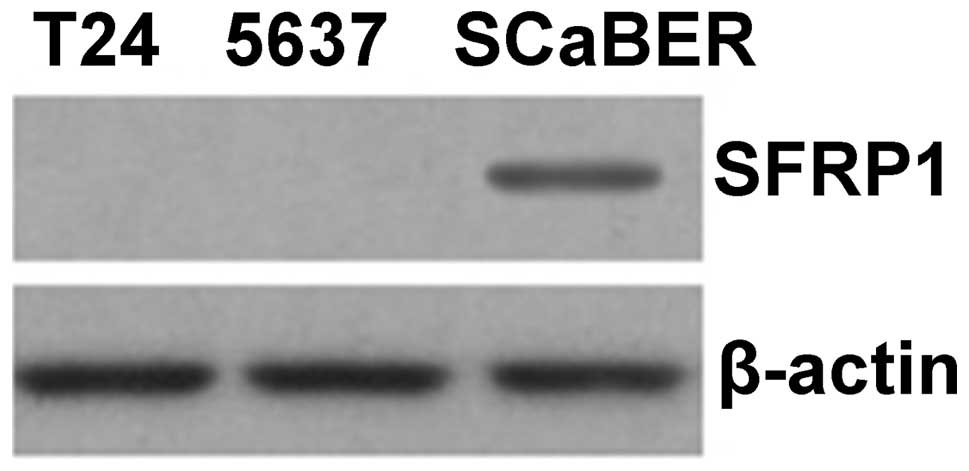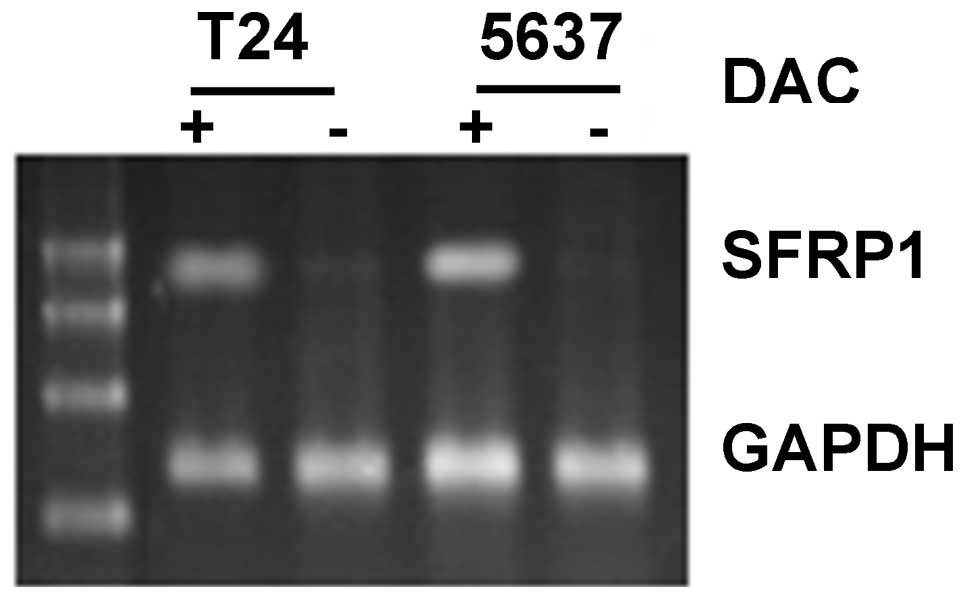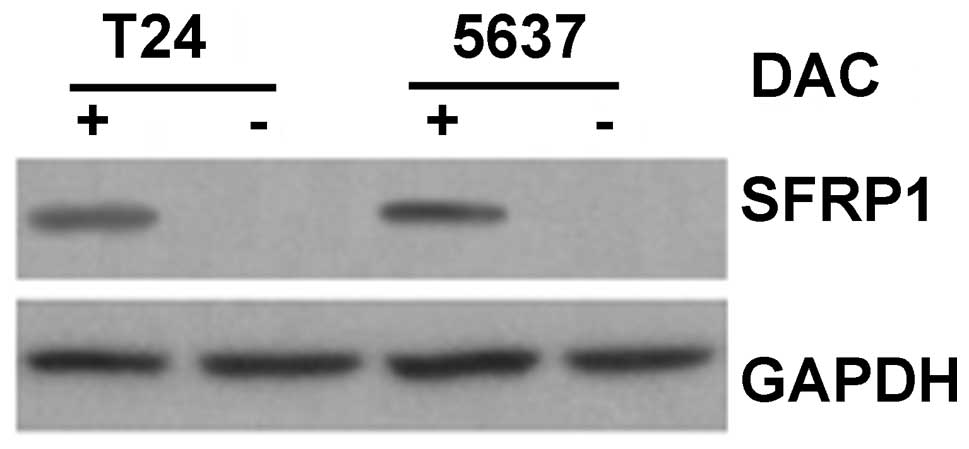Methylation and aberrant expression of the Wnt antagonist secreted Frizzled-related protein 1 in bladder cancer
- Authors:
- Published online on: May 11, 2012 https://doi.org/10.3892/ol.2012.713
- Pages: 334-338
Abstract
Introduction
The Wnt family is a group of glycoproteins characterized by a number of conserved cysteine residues. These Wnt proteins are extensively involved in embryonic development and the regulation of adult cell proliferation, differentiation and apoptosis (1). The secreted Frizzled-related protein family (SFRPs), including five members ranging from secreted frizzled-related protein 1 (SFRP1) to SFRP5, are Wnt antagonists. These members possess a characteristic cysteine-rich domain (CRD), which is extremely similar to the CRD of the Wnt receptor Frizzled protein family. Consequently, SFRPs can also combine with Wnt through the CRD to dampen cellular signal transduction (2). Downregulated expression of the Wnt antagonists can lead to the combination of more Wnt proteins with the receptor, Frizzled. This event results in reduced degradation of GSK3 on its substrate β-catenin, which translocates into the nucleus and has an impact on the transcription factor TCF/LEF. In turn, this regulates the transcription of the target genes c-myc and cyclinD1, causing excessive cell proliferation and thereby inducing tumorigenesis. Downregulated expression of SFRP1 occurs in several types of cancer. For example, Zou et al reported that in esophageal cancers, SFRP1 and other Wnt antagonists are widely methylated (3), while Lodygin et al found that the SFRP1 gene was also methylated in prostate cancer (4). These studies demonstrate that SFRP1 gene methylation is the primary mechanism underlying the repression of SFRP1 in these tumors.
The mechanisms underlying the pathogenesis of bladder cancer, the most common urinary tract cancer, remain unclear. Previous studies have shown that abnormal Wnt signaling is also involved in the pathogenesis of bladder cancer. For example, it has been demonstrated that the expression of the Wnt family member, Wnt7b, is significantly higher in superficial bladder cancer than in normal bladder tissue (5). Similarly, the overexpression of Wnt5A has been demonstrated in a bladder cancer cell line (6). Furthermore, the expression of Wnt antagonists, including Wnt inhibitory factor 1 (WIF1), is downregulated in bladder cancer via a gene promoter methylation-related mechanism (7). In the present study, we investigated the mechanisms underlying SFRP1 expression in bladder cancer and explored the role of altered SFRP1 expression in the pathogenesis of bladder cancer.
Materials and methods
Materials
Samples were obtained from the Department of Urology, Shengjing Hospital affiliated to China Medical University. Among the 45 bladder cancer tissue samples, 28 were from males and 17 from females, with an age range of 45–66 years old and mean age of 52 years old. Selected patients with a solitary bladder tumor underwent partial cystectomy and postoperative pathology led to a diagnosis of urothelial carcinoma. Exclusion criteria involved multiple bladder tumors and bladder cancer recurrence following surgery. A total of 45 normal tumor-adjacent tissues, corresponding to each bladder cancer specimen, were also used in this study, with the inclusion criterion that the normal bladder incisal edge was ≥2 cm from the tumor margin. The samples were frozen in liquid nitrogen and stored at −80°C until use. The study was approved by the Ethics Committee of China Medical University and consent was obtained for all of the specimens, from patients or their family members. The human bladder cancer cell lines T24, 5637 and SCaBER were purchased from Shanghai Kunken Biochemical Engineering Co., Ltd., China.
Cell culture
The human bladder cancer cell lines T24, 5637 and SCaBER were cultured in RPMI-1640 culture medium and placed in an incubator with 5% CO2 at 37°C. The medium contained 10% fetal bovine serum, penicillin (100 IU/ml) and streptomycin (100 μg/ml).
Methylation-specific PCR
The Genmed gene methylation detection kit (Shanghai Genmed Gene Pharmaceutical Technology Co., Ltd., Shanghai, China) was used to determine the methylation status of the SFRP1 gene. Specific steps included a transformation experiment and methylation-specific PCR (MSR) detection. The PCR conditions were as follows: 95°C for 5 min for 1 cycle and 95°C, 30 sec; 58°C, 30 sec; 72°C, 30 sec; for 35 cycles. Methylation detection included detection by a methylated (M) reaction and unmethylated reaction (U). The primer sequences used were: M, forward: 5′-TGTAGTTTTCGGAGTTAGTGTCGCGC-3′; and reverse: 5′-CCTACGATCGAAAACGACGCGAACG-3′; forward: 5′-GTTTTGTAGTTTTTGGAGTTAGTGTTGTGT-3′; and reverse, 5′-CTCAACCTACAATCAAAAACAACACAA ACA-3′.
RNA extraction and reverse transcription PCR (RT-PCR)
TRIzol (Takara Bio Inc., Shiga, Japan) was used for RNA extraction and the specific steps involved are described in the instruction manual. Nine random primers and AMV reverse transcriptase (Takara Bio, Inc.) were used for cDNA synthesis. The total reaction volume was 10 μl, with reverse transcription reaction conditions consisting of: 30°C, 10 min; 42°C, 25 min; 99°C, 5 min; and 5°C, 5 min for 1 cycle. The total volume for the PCR was 40 μl, with the following reaction conditions: 94°C, 2 min for 1 cycle and 94°C, 30 sec; 58°C, 30 sec; and 72°C, 2 min for 30 cycles. The PCR conditions used were: 94°C, 2 min for 1 cycle, 94°C, 30 sec; 60°C, 30 sec; 72°C, 2 min, for a total of 30 cycles. Primer sequences used were: SFRP1, forward: 5′-TCTACACCAAGCCACCTCAG-3′; and reverse: 5′-CAGTCACCCCATTCTTCAGG-3′; and for the GADPH gene, forward: 5′-GGGAAACTGTGGCGTGAT-3′; and reverse: 5′-AAAGGTGGAGGAGTGGGT-3′.
Western blotting
Lysis buffer (50 mmol/l Tris-HCl, 100 mmol/l DTT, 2% SDS, 0.1% bromophenol blue and 10% glycerol) was used for cell lysis, protein sample collection and SDS-PAGE gel electrophoresis. SFRP1 (Santa Cruz Biotechnology, Inc., Santa Cruz, CA, USA) polyclonal antibodies and horseradish peroxidase-conjugated rabbit anti-goat antibodies (Santa Cruz Biotechnology, Inc.) were diluted at 1:1000. β-actin (Santa Cruz Biotechnology, Inc.) was used as the loading control.
Statistical analysis
The extent of methylation in bladder cancer tissue and tumor-adjacent tissue was compared using χ2 tests. mRNA expression (gray value) was compared using Student’s t-tests. P<0.05 was considered to indicate a statistically significant result. SPSS 11.5 software (Chicago, IL, USA) was used for statistical analysis.
Results
Methylation and abnormal expression of the SFRP1 gene in bladder cancer and normal tumor-adjacent tissue
Through methylation-specific PCR, we determined the methylation status of SFRP1 in 45 cases of bladder cancer and their corresponding normal tumor-adjacent tissues. Of the 45 patients with bladder cancer, methylation of SFRP1 was detected in 28 tumor samples (62.2%). In the corresponding normal tumor-adjacent tissues, SFRP1 was methylated in only 6 cases (13.3%). The frequency of SFRP1 methylation in bladder cancer tissues was significantly higher than that in the adjacent tissues (P<0.01, χ2=22.88, Fig. 1, Table I).
The expression of SFRP1 mRNA was analyzed by RT-PCR in 10 bladder cancer specimens and the corresponding normal tumor-adjacent tissues. SFRP1 was methylated in 5 of the 10 bladder cancer tissues, but was unmethylated in the remaining five. In the five bladder cancer tissues demonstrating methylation of the SFRP1 gene, it was found that SFRP1 mRNA expression was significantly lower than that in the corresponding normal tissues (P<0.01, Fig. 2). In the five bladder cancer tissues that did not demonstrate methylation of the SFRP1 gene, there was no significant difference in SFRP1 mRNA expression compared to normal tumor-adjacent tissues.
Methylation and abnormal expression of the SFRP1 gene in bladder cancer cell lines
Using MSR, the methylation status of the SFRP1 gene was analyzed in the bladder cancer cell lines T24, 5637 and SCaBER. The data revealed that SFRP1 is methylated in T24 and 5637 cells, but unmethylated in SCaBER cells (Fig. 3).
RT-PCR was used to determine the expression of SFRP1 mRNA in bladder cancer cell lines. We found that SFRP1 mRNA was not expressed in T24 and 5637 cells, in which SFRP1 was methylated, but was expressed in SCaBER cells, which do not demonstrate methylation of SFRP1 (Fig. 4). The expression of SFRP1 protein was then analyzed in bladder cancer cell lines by western blotting. Similar to our findings at the mRNA level, it was found that the SFRP1 protein was not expressed in T24 and 5637 cells, where SFRP1 is methylated, but was expressed in SCaBER cells, which do not demonstrate methylation of SFRP1 (Fig. 5).
Effect of a demethylating reagent on expression of the SFRP1 gene in bladder cancer cell lines
The bladder cancer cell lines, T24 and 5637, in which the SFRP1 gene is normally methylated, were treated for 6 h with the demethylating agent 5′-aza-deoxycytidine acid (DAC, 1 μg/ml). Following treatment, methylation of the SFRP1 gene in the two cell lines had disappeared (Fig. 6). Furthermore, using RT-PCR, it was found that SFRP1 mRNA expression increased in DAC-treated T24 and 5637 cells (Fig. 7) and that this was accompanied by an increase in SFRP1 protein, as determined by western blotting (Fig. 8).
Discussion
The pathogenesis of cancer is a complicated process, involving a series of hereditary and certain epigenetic changes that ultimately result in uncontrolled cell growth. Epigenetic changes, including abnormal DNA methylation, are significant tumor-inducing mechanisms through their effects on oncogene activation or anti-oncogene inactivation (8). DNA methylation occurs though the interaction of three types of DNA methyltransferases, DNMT1, DNMT3A and DNMT3B, leading to the addition of a methyl group to the fifth carbon atom of cytosine. Methylation typically occurs in CG repetitive sequences within the CpG islands of gene promoters, although the majority of these sequences are not methylated under normal circumstances. However, under the influence of pathogenic factors, CG sequences within gene promoters can become methylated, thereby suppressing transcription. The mechanism involved may be related to the fact that the methylation of cytosine prevents transcription factors from combining with recognition sites within CG sequences. Since it was first discovered approximately 20 years ago that cytosine is methylated in tumors, an increasing number of gene promoters have been identified that may become methylated, leading to transcriptional suppression. Although the mechanism of methylation is not fully understood, it is likely to be associated with a deficiency of protective factors that compete with the methyl transferase for binding sites on the cytosine.
The Wnt gene was discovered in 1982 and since then a large body of research has revealed that the Wnt gene family is widely involved in essential developmental processes in embryos, including Drosophila segmentation, murine nerve development, axis formation and toad muscle production among others. The finding of the Wnt signaling pathway antagonist heralded a new era in the study of the Wnt gene and its effects. Currently known Wnt antagonists include SFRPs and Dickkopf (Dkk). The SFRP family consists of five members, SFRP1-5. Similar to the other members of the SFRP family, SFRP1 is one of the secretory proteins of 36 kDa and is made up of over 300 amino acids. SFRP1 contains a signal peptide, a CRD near the amino terminal and a hydrophilic carboxyl terminus. Consisting of approximately 110 amino acid residues and 10 highly conserved cysteines, the CRD area has 30–40% homology with the Frizzled extracellular CRD. Studies have revealed that SFRP1 is capable of stimulating apoptosis and suppressing cell proliferation (9–11).
Since SFRP1 is able to negatively regulate the Wnt signal transduction pathway and stimulate apoptosis, downregulation of SFRP1 expression generally causes overactivation of the Wnt signal transduction pathway, increased cell proliferation and tumorigenesis. In recent years, the Dkk and SFRP family members, which are SFRP1 antagonists, were recognized to be downregulated in tumors. Since the SFRP1 gene is located on chromosome 8p11.2, which is incomplete in many types of tumors, the SFRP1 gene is suspected to be a tumor suppressor gene.
In this study, 45 specimens of bladder cancer with their corresponding normal tumor-adjacent tissues were analyzed and it was found that SFRP1 was methylated in 62.2% of bladder cancer specimens and in 13.3% of normal tumor-adjacent tissues. Statistical analysis revealed that methylation of the SFRP1 gene in cancer tissues occurs more frequently than in its corresponding normal tumor-adjacent tissues. Analysis of SFRP1 mRNA expression in 10 specimens of bladder cancer and their normal adjacent tissues by RT-PCR revealed that methylation of the SFRP1 gene is significantly lower than that in normal tumor-adjacent tissues. Conversely, SFRP1 mRNA expression in cancer specimens that do not demonstrate methylation of the SFRP1 gene is not markedly different to that in adjacent normal tissues. Thus, our data prove that SFRP1 methylation is common in bladder cancer and suggest that the downregulated SFRP1 expression is likely to be due to the methylation of the SFRP1 gene.
To analyze the methylation and expression status of the SFRP1 gene in bladder cancer, three types of bladder cancer cell lines were used. It was found that the SFRP1 gene was methylated in the T24 and 5637 cell lines and that there was also a reduced expression of SFRP1 mRNA and protein in these cells. Furthermore, upon treatment with a demethylating reagent, SFRP1 mRNA and protein expression re-occurred in these cells. These results provide further evidence that SFRP1 expression is frequently downregulated in bladder cancer and that this downregulation is mainly due to the abnormal methylation of SFRP1.
According to our findings, we hypothesize that methylation of the SFRP1 gene and the consequent downregulation of protein expression is partially involved in the pathogenesis of bladder cancer. The mechanism involved is likely to be related to the over-activation of the Wnt signaling pathway. Since the Wnt signaling pathway is divided into the classical β-catenin and other non-classical pathways, and β-catenin was not detected in the cytoplasm, the specific molecular mechanisms by which downregulation of SFRP1 expression is involved in the pathogenesis of bladder cancer remains unclear. To fully define the role of abnormal SFRP1 expression in the pathogenesis of bladder cancer, the involvement of genes, including c-myc and cyclinD1, that may be modulated by the downregulation of SFRP1 expression should be analyzed.
Acknowledgements
This study was supported by grants from Liaoning Natural Science Foundation (20092138).
References
|
Katanaev VL: The Wnt/Frizzled GPCR signaling pathway. Biochemistry (Mosc). 75:1428–1434. 2010. View Article : Google Scholar : PubMed/NCBI | |
|
Esteve P and Bovolenta P: The advantages and disadvantages of sfrp1 and sfrp2 expression in pathological events. Tohoku J Exp Med. 221:11–17. 2010. View Article : Google Scholar : PubMed/NCBI | |
|
Zou H, Molina JR, Harrington JJ, et al: Aberrant methylation of secreted frizzled-related protein genes in esophageal adenocarcinoma and Barrett’s esophagus. Int J Cancer. 116:584–591. 2005.PubMed/NCBI | |
|
Lodygin D, Epanchintsev A, Menssen A, Diebold J and Hermeking H: Functional epigenomics identifies genes frequently silenced in prostate cancer. Cancer Res. 65:4218–4227. 2005. View Article : Google Scholar : PubMed/NCBI | |
|
Bui TD, O’Brien T, Crew J, Cranston D and Harris AL: High expression of Wnt7b in human superficial bladder cancer vs invasive bladder cancer. Br J Cancer. 77:319–324. 1998. View Article : Google Scholar : PubMed/NCBI | |
|
Zhuang L, Zhang Z and Guo Y: Aberrant expression of growth factor Wnt-5A in six urinary malignant cell lines. Chin Med J (Engl). 112:251–255. 1999.PubMed/NCBI | |
|
Urakami S, Shiina H, Enokida H, et al: Epigenetic inactivation of Wnt inhibitory factor-1 plays an important role in bladder cancer through aberrant canonical Wnt/beta-catenin signaling pathway. Clin Cancer Res. 12:383–391. 2006. View Article : Google Scholar : PubMed/NCBI | |
|
Tycko B: Cancer epigenetics and targeted therapies. Oncology (Williston Park) 25. 228:2312011.PubMed/NCBI | |
|
Ezan J, Leroux L, Barandon L, et al: FrzA/sFRP-1, a secreted antagonist of the Wnt-Frizzled pathway, controls vascular cell proliferation in vitro and in vivo. Cardiovasc Res. 63:731–738. 2004. View Article : Google Scholar : PubMed/NCBI | |
|
Häusler KD, Horwood NJ, Chuman Y, et al: Secreted frizzled-related protein-1 inhibits RANKL-dependent osteoclast formation. J Bone Miner Res. 19:1873–1881. 2004.PubMed/NCBI | |
|
Bodine PV, Zhao W, Kharode YP, et al: The Wnt antagonist secreted frizzled-related protein-1 is a negative regulator of trabecular bone formation in adult mice. Mol Endocrinol. 18:1222–1237. 2004. View Article : Google Scholar : PubMed/NCBI |




